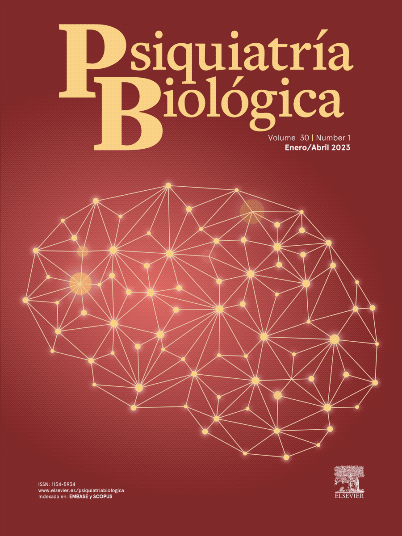Fundamento: El objetivo de este estudio fue el determinar si las esquizofrenias con altas y bajas puntuaciones en la Escala del Síndrome Positivo y Negativo (PANSS) se diferencian entre sí en lo que atañe a las puntuaciones del Inventario Psicopatológico de Frankfurt en su tercera versión (FBF-3); también si los esquizofrénicos considerados positivos y los considerados negativos en la PANSS se diferencian en las puntuaciones del FBF-3.
Pacientes y métodos: Se incluyerón un total de 40 pacientes esquizofrénicos. Para la evaluación de la psicopatología se utilizó la PANSS. Los pacientes fueron divididos en cuatro grupos, excluyentes de dos en dos, de acuerdo con esta escala: grupo con alta puntuación (n = 28), grupo con baja puntuación (n = 12), grupo esquizofrenia negativa (n = 29), grupo esquizofrenia positiva (n = 11). Para la evaluación de los síntomas básicos se utilizó el FBF-3.
Resultados: Los esquizofrénicos que puntúan más bajo en la PANSS alcanzan puntuaciones más bajas en todas las subescalas del FBF-3 con una diferencia significativa (p ¾ 0,05) en la subescala percepción simple y el factor percepción y motilidad (F2). Los esquizofrénicos negativos puntúan significativamente (p ¾ 0,05) más alto en la subescala pensamiento. Si se realiza una correlación entre los elementos de la PANSS y los del inventario FBF, teniendo presente una significación del 0,001, son las subescalas del inventario FBF percepción simple, motilidad y anhedonía y el factor percepción y motilidad (F2) los que se correlacionan con los elementos de la PANSS, siendo tres de ellos del síndrome positivo, uno del síndrome negativo y dos del general.
Conclusiones: Podemos decir que los síntomas básicos aunque en principio parecen ser más frecuentes en los esquizofrénicos negativos, son tanto elementos del síndrome positivo como del negativo y del general, e indican vulnerabilidad a la enfermedad.
Background: The aim of this study was to determine whether the schizophrenias with high and low scores in the Positive and negative Syndrome Scale (PANSS) differ amongst themselves in regard to the scores of the Frankfurt Complaint Questionnaire (FBF-3) and whether the schizophrenics considered positive and negative with the PANSS also differ in the scores of the FBF-3.
Patients and methods: Forty schizophrenic patients were included in the study. To assess the psychopathology of the patients the PANSS was used. The patients were divided into four groups, according to the following scale: group with high score (n = 28), group with low score (n = 12), negative schizophrenic group (n = 29), positive schizophrenic group (n = 11). The FBF-3 was used to evaluate the basic schizophrenic symptoms.
Results: The schizophrenics with the lowest PANSS score achieved the lowest scores in all the subscales of the FBF-3 with a significant difference (p ¾ 0.05) in the simple perception subscale and the perception and motility factor (F2). The negative schizophrenics showed significantly higher scores (p ¾ 0.05) in the thought subscale. On correlating the PANSS elements and those of the FBF-3, with a value of significance of 0.001, the subscales of the FBF-3 of simple perception, motility and anhedonia and the perception and motility factor (F2) were found to correlate with the PANSS elements, with three from the positive syndrome, one from the negative syndrome and two from the general syndrome.
Conclusions: Although the basic schizophrenia symptoms appear to be more frequent in the negative schizophrenics, the elements of the positive, negative and general syndromes are also frequent thereby indicating the vulnerability to the disease.
Artículo
Comprando el artículo el PDF del mismo podrá ser descargado
Precio 19,34 €
Comprar ahora






